
Christmas is a period typically marked by excess, either in terms of consumerism and frenzy regarding gifts or in the food we take to the table. To counter the trend, we sinned by default, but only in showing affection. So, we decided to make you a balanced proposal to nourish the body with the calories necessary for its healthy functioning, challenging the Nutrition Laboratory to prepare a menu for a sustainable Christmas supper.
The proposal is authored by Chef and holder of a Master Degree in Clinical Nutrition from FMUL/ESTeSL (Lisbon Higher School of Health Technology) Emanuel Cunha, in partnership with the team of our Advanced Nutrition Centre, namely Professor Joana Sousa and Nutritionists and Researchers João Vasques, Vitória Dias da Silva and Mariana Liñan.
The Chef, who in his day-to-day life is responsible for making meals for cancer patients at the Champalimaud Foundation, is used to the rigorous technical sheet of the menu he prepared this afternoon, which lasted for several hours and whet our appetite until the early evening.
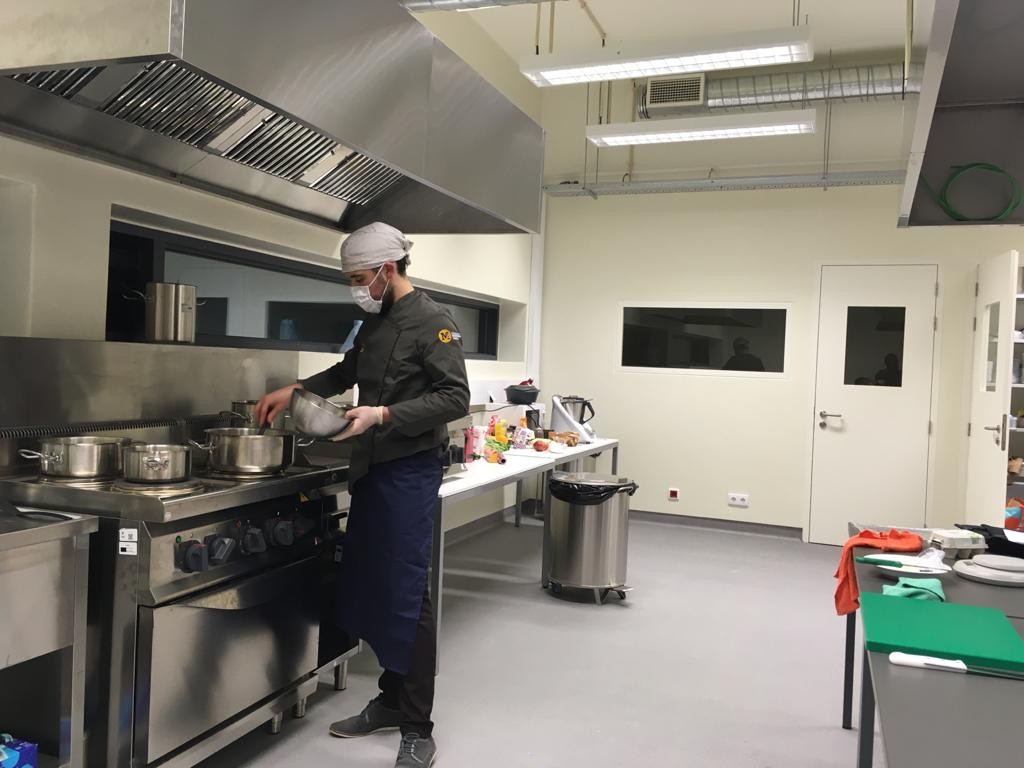
And it was in the professional kitchen of the Advanced Nutrition Centre, at the Reynaldo dos Santos Building, that a true gastronomic show took place. Maximum attention to detail was constant, as all ingredients were quantified in detail and the nutritional value of each dish was meticulously calculated by the team at our Nutrition Laboratory.
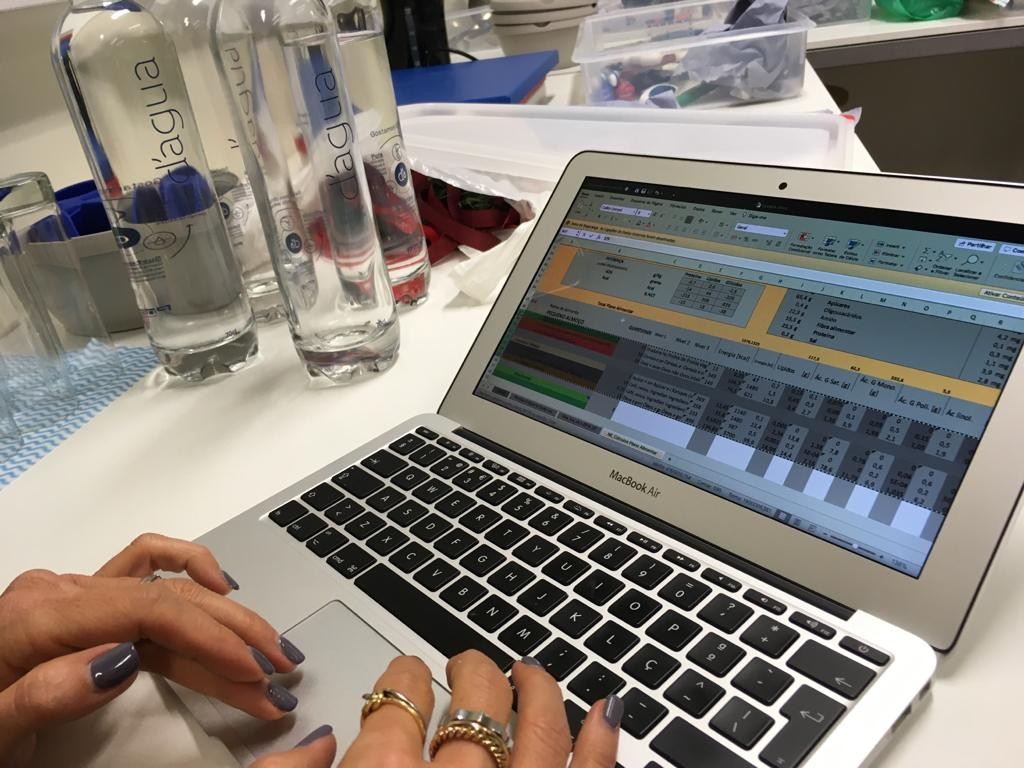
The result is an appetizing, healthy and refined menu, which promises to conquer even the most demanding palates.
For starters, Green Olive Tapenade and Beetroot Hummus are suggested. This is followed by the soup, which is mandatory at the table, and the option for this special menu is the cream of cauliflower and pear.
As a main dish, three options are available: a meat dish, a fish dish and a vegetarian dish. The faithful friend on the Christmas Supper is the famous cod, and the recipe we propose is Poached cod with sweet potatoes and roasted tomatoes. But if you prefer a meat dish, alternatively we invite you to taste the turkey tenderloin stuffed with chestnuts and sultans rice. And thinking especially of those who follow a vegetarian diet, we prepared a Potato and Lentil Rosti. To accompany the meal, water flavoured with pomegranate, orange and rosemary leaves.
The desserts are also varied and combine tradition with contemporaneity in a gastronomic display that makes your mouth water. Try one or try a little of all, after all the occasion is festive. From Baked French toast to Pears Cooked in Red Wine with red fruit ice cream and chocolate foam with pumpkin, there are plenty of options to sweeten your supper this Christmas.
Then, we shared the information and all the details of the menu, from the ingredients to the cooking method, which the FMUL Nutrition Laboratory team produced to mark this festive season.
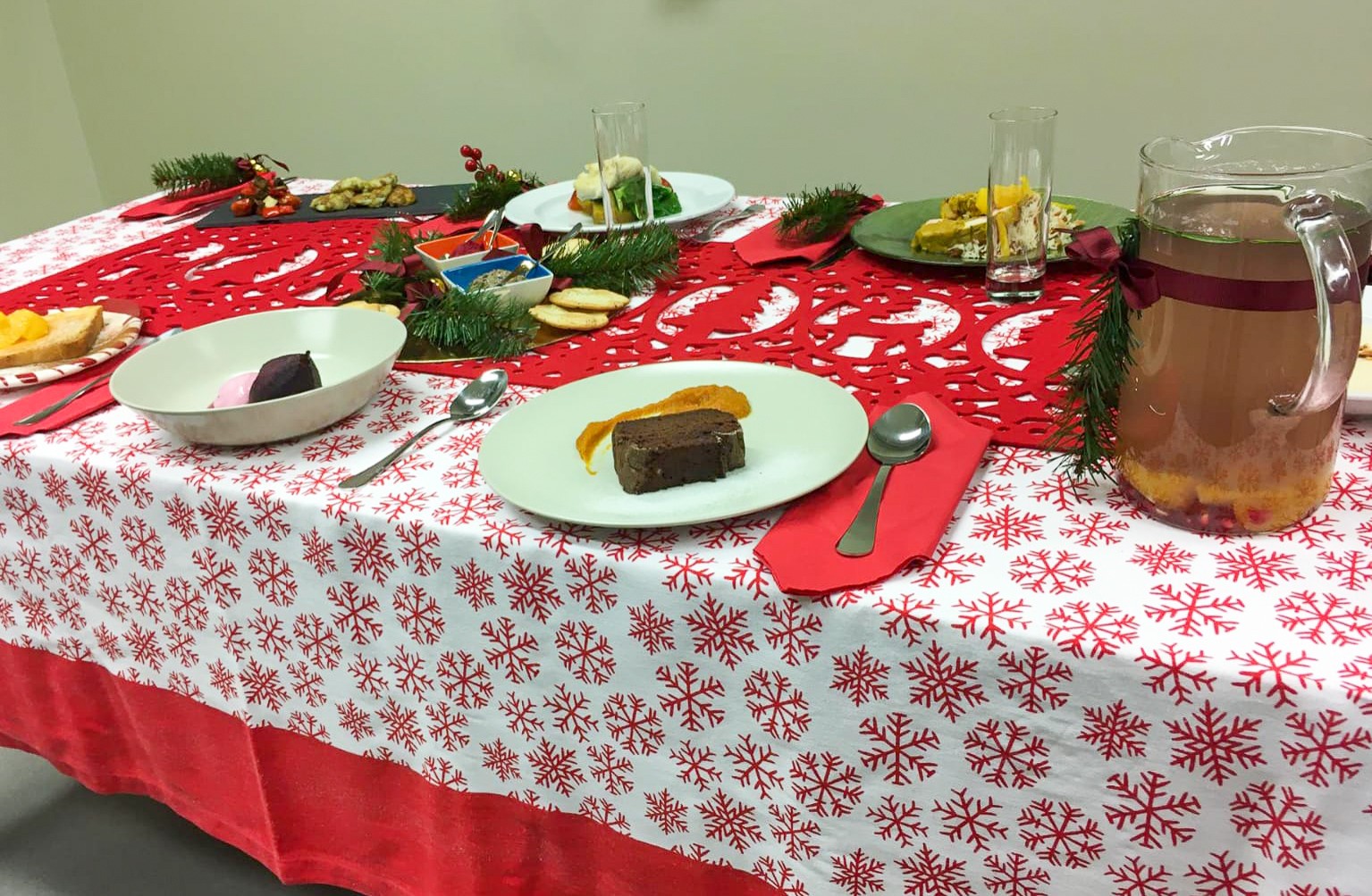
Inadequate eating habits are a constant reality throughout the year, and this is the 5th main factor for the loss of years of healthy life. There are festive seasons throughout the year that are associated with high potential for the practice of inappropriate eating habits. The Christmas period that runs until Epiphany, including the New Year, is an example of this. Eating habits change significantly and are characterized by excessive consumption of sugar, salt and fat, and leftover food is a common reality. Recreating the Christmas menu, making typical dishes healthier and more sustainable, was the challenge posed to the FMUL Advanced Nutrition Centre.
The celebration of Christmas is an opportunity to socialize around the table and to share traditions, flavours and knowledge. This year we must not forget that it will have to be different and we must adopt all the recommended protective measures. But it is possible to celebrate!
This is also an excellent opportunity to share the principles of the Mediterranean diet, since it is recognized as a food standard with favourable effects on health status, and it is economically and environmentally sustainable. The Christmas menu presented here is based on the principles of the Mediterranean diet, as it is characterized by the predominance of products of vegetable origin, such as vegetables, fruit, cereals, oleaginous fruits and pulses, and by the use of olive oil as the main source of fat. Additionally, when presenting the amount of food per person, this Christmas menu respects the balance between quality and adequate quantity in food intake, thus respecting the principle of frugality.
Suggestions for a more sustainable Christmas:
- Start Christmas meals with a seasonal vegetable soup (pumpkin, watercress, Portuguese cabbage, broccoli, cauliflower, for example), promoting satiety and hydration;
- Accompany meals with vegetables, varying the forms of preparation and cooking;
- Don't forget pulses (like chickpeas and beans). Use them for delicious starters or as a side dish;
- Eat seasonal fruit (pineapple, pomegranate, kiwi, pear, apple, orange, tangerine, persimmon), adding colour, texture and aroma to the meal;
- Choose fresh bread of different varieties of cereals or wholemeal. It provides less calories, fat and salt than crackers, snacks and other appetizers, besides having excellent digestibility and being a good source of fibre and vitamins;
- Eat dried fruits (such as figs, raisins and apricots) and oilseeds (such as walnuts, almonds and hazelnuts) without adding salt or sugar as an alternative to crackers, sweet snacks and cakes, but eat in moderation.
- Use olive oil as preferred fat. Use it in its extra virgin version, both to season and to cook your meals, but do not forget that it is a fat, so your consumption should be moderate;
- You do not need to add salt to meals. Use aromatic herbs (for example parsley, coriander, oregano, chives, thyme) to add flavour;
- Provide jars of water flavoured with lemon or orange peel, pomegranate, cinnamon, or mint, for example. Tap water is of good quality and its intake can contribute to better diuresis, to regulate blood pressure, increase satiety and avoid excessive consumption of sugary and alcoholic beverages with higher caloric value;
- Prepare new dishes using leftover food, helping to reduce food waste.
Based on the 10 suggestions above, we present below the menu suggested by the Advanced Nutrition Centre of the FMUL, consisting of 10 options.
Nutritional information is presented on each dish compared to the traditional Christmas season alternative.
Recipe for 4 people and nutritional information per person (DRI: Recommended Daily Dose; HC: Carbohydrates; AAR: Rapid Absorption Sugars; AGS: Saturated Fatty Acids; AGP: Polyunsaturated Fatty Acids; AGM: Monounsaturated Fatty Acids.)
Menu, nutritional information and ANC “Tips”

DRINK
- Flavoured water
Water is the favourite drink here and contributes to maintaining hydration without providing calories. Flavoured waters are excellent options, which can replace the typical sugary drinks, so it is a great option to have them in jars on your Christmas table. Preferably choose tap water, which has excellent quality and does not need to be transported in packaging. We suggest using pomegranate berries, orange or lemon peel, cinnamon stick, hibiscus and mint, as they are seasonal products with a festive colour appropriate to the holiday season.
INGREDIENTS (4 pax.)
2 Lt. Water
1 Pomegranate
1 Rosemary sprig
1 Cinnamon stick
1 Orange
PREPARATION
Wash the orange and peel the pomegranate. In a saucepan, boil water with the segments of the pomegranate, orange peel and a cinnamon stick. Allow to cool. Strain the water and serve in a jar with orange pieces, pomegranate and rosemary.

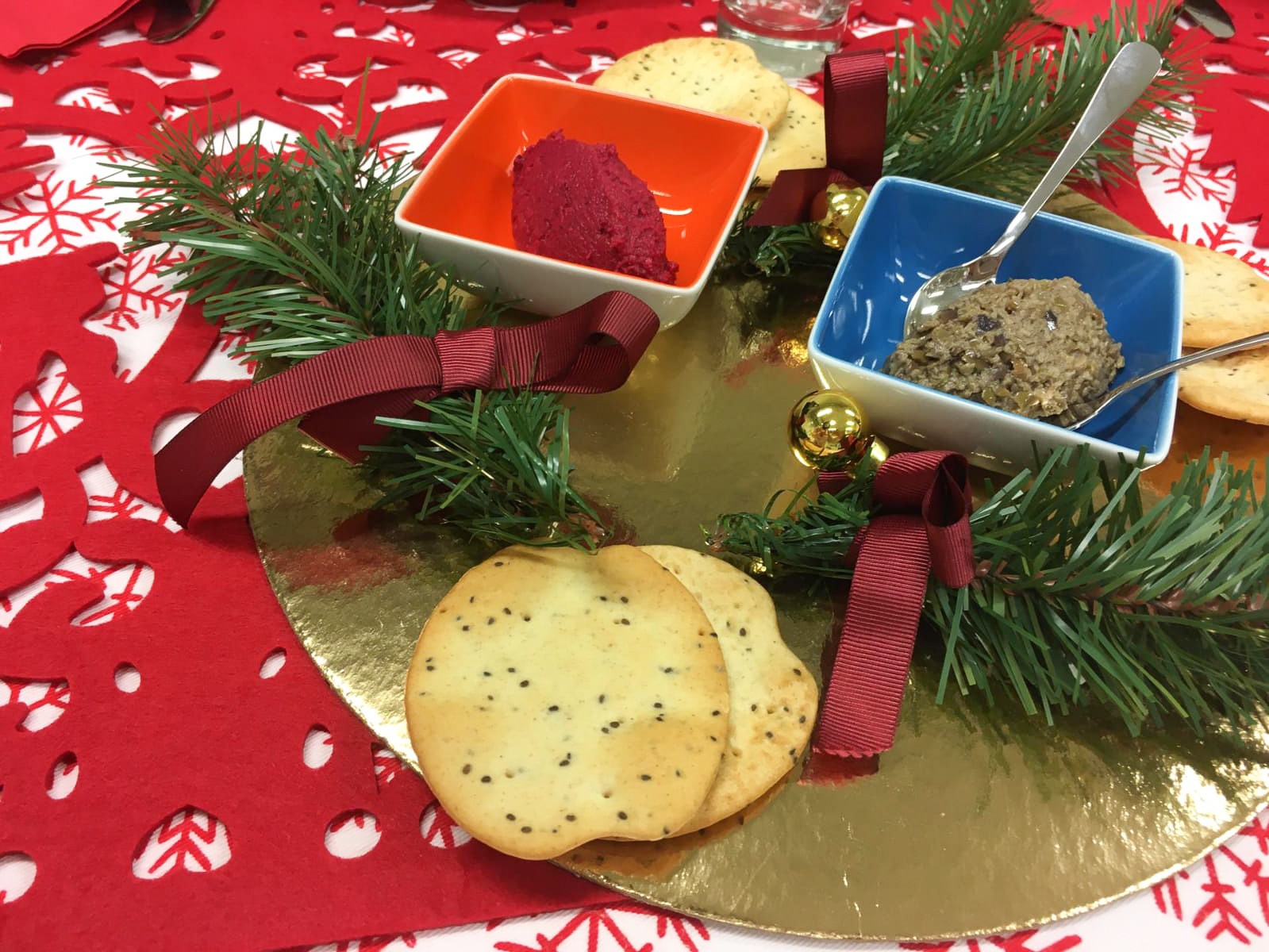
Starter
- Olive tapenade
The olive tapenade is intended as a starter that can replace the typical pâtés, with a lower energy value and content of saturated fat and salt. This recipe is mainly composed of the raw material for obtaining olive oil, characteristic of the Mediterranean food pattern. This fat is associated with reduced cardiovascular risk, as it plays a role in reducing inflammation and vasodilation.
INGREDIENTS (4 pax.)
80g Pitted Green Olives
1 Tb spoon olive oil
1 Garlic clove
PREPARATION
In a deep container, place all the ingredients and grind well in a food processor. Serve!
Nutritional information (per person)

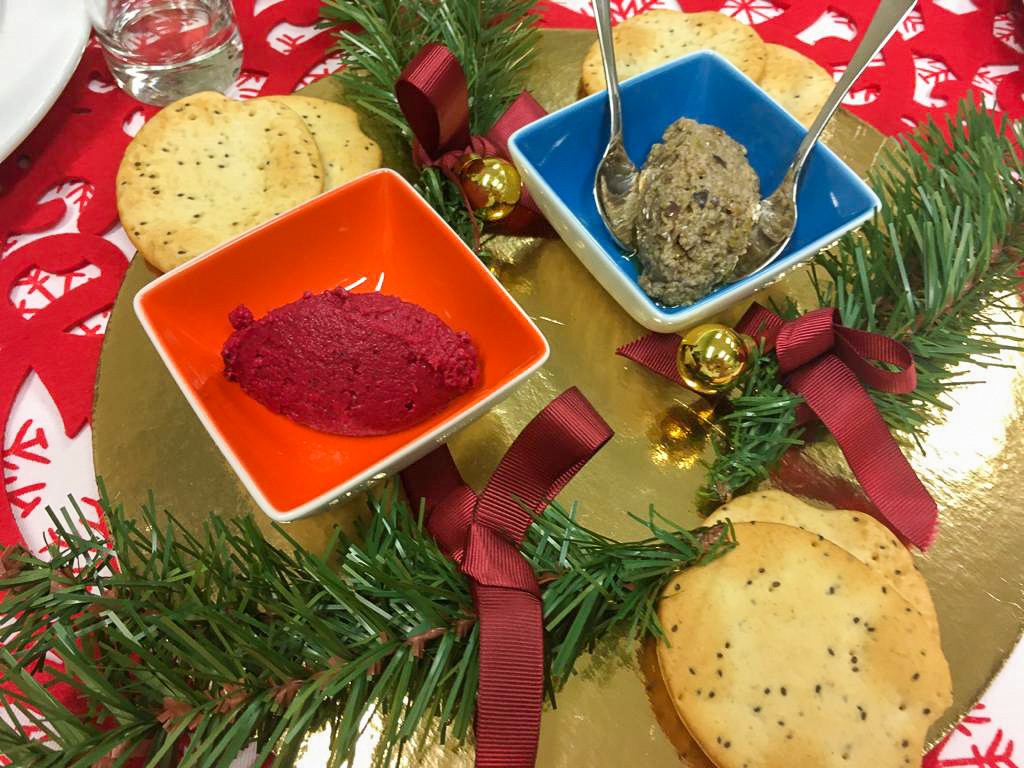
STARTER
- Beetroot humus
Humus was included because it is a nutritionally balanced starter and because it includes pulses, a type of food that is often “overlooked”. Pulses (e.g., chickpeas, beans, peas or lentils) are especially rich in complex carbohydrates, proteins, fibres, B vitamins and minerals. Due to their nutritional characteristics, pulses seem to have a role in preventing diabetes, cardiovascular disease and obesity. To promote the consumption of vegetables in this recipe, we add the beetroot to the humus, also giving this entry an appealing colour.
INGREDIENTS (4 pax.)
200g Beetroot
40g Cooked chickpeas
1 Tb spoon Olive oil
2 Tb spoon Lemon juice
1 T spoon Tahini (sesame paste)
Garlic powder (pinch)
Cumin (pinch)
PREPARATION
Roast the whole beetroot at 160ºC until fully cooked (wrapped in aluminium foil - optional). In a deep container, place all the ingredients and crush well in a food processor. Check seasoning and serve!
Nutritional information (per person)


SOUP
- Cream of cauliflower and pear
Nothing better than a soup to start the meal. It contributes to hydration and the consumption of vegetables that are excellent sources of fibre, vitamins, minerals and antioxidants. It has a low energy value, but at the same time an excellent satiating power. Combining these two characteristics is very relevant in festive periods, such as the Christmas season. For Christmas dinner, we suggest a vegetable cream different from the usual, also including fruit.
.
INGREDIENTS (4 pax.)
400g Cauliflower
20g Fresh rosemary
Black Peppercorn (pinch)
Nutmeg (pinch)
2 Small rocha pears
1300 ml water
500ml Skimmed milk (optional – add just 800 ml water)
2 Tb spoons laminated almonds
PREPARATION
Prepare the cauliflower and break into pieces. Place in a medium saucepan, add water. Season with black pepper, nutmeg and rosemary. Let it cook. Roast the almonds in the oven at 170ºC until golden (stirring the almonds from time to time during the process). Halfway through cooking the cauliflower, add the pears (peeled and pitted), let it cook. If you run out of juice, add boiling water. Once everything is cooked, grind very well in a food processor. Rectify seasonings and serve garnished with roasted almonds.
Nutritional information (per person)

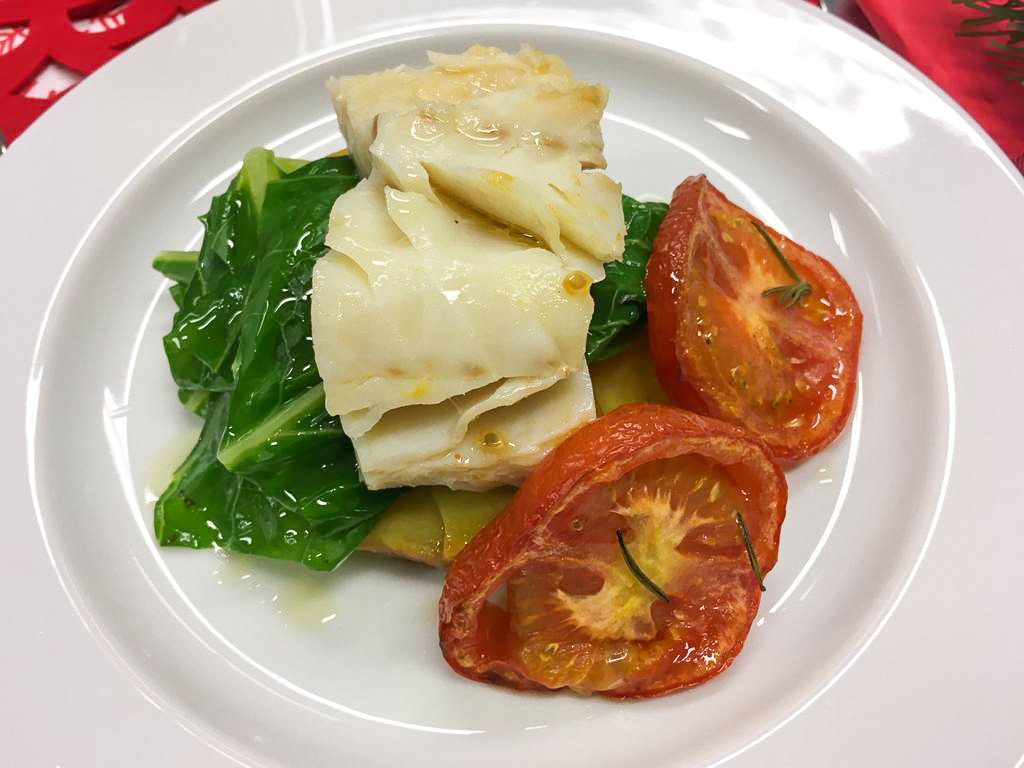
FISH DISH
- Poached cod
In some regions of the country, Christmas supper is “synonymous” with cod. Thus, in order to preserve tradition, we present cod as the main ingredient and suggest using an alternative cooking technique to the typical cooked cod. For its nutritional composition and, mainly, for its low fat content, cod is recognized as a lean fish (<2g of fat/100g). Cod is a naturally salted fish (it has 3g salt/100g), so the addition of salt during cooking should not take place. Thus, in this recipe, to add flavour to the meal, we suggest seasoning with spices and aromatic herbs, such as pepper and bay leaves.
INGREDIENTS (4pax.)
400g Dry, salted and soaked cod loin
400g Sweet potato
6 Tb spoons olive oil
800g Portuguese Cabbage
1 Large round tomato
1 Bay Leaf
1 Garlic clove
Black peppercorns (pinch)
PREPARATION
Wash and scrape the sweet potato, and bake in the oven at 170ºC with a drizzle of olive oil. Prepare the Portuguese cabbage. Wash and slice the tomato. Bake at 170ºC with a drizzle of olive oil, for 10 minutes. Place the cod loins in a pan with water and aromatic ingredients (garlic clove, bay leaf and pepper). As soon as it boils, turn off the heat and leave the cod in the hot water for 2 to 3 minutes. Clean the water with a slotted spoon and bring to the boil. Cook the cabbage for 3 to 4 minutes. Once the sweet potato is roasted, remove it from the oven, peel and cut into slices. Place the sweet potatoes and cabbage on the bottom, followed by the cod loin and the tomato.
Nutritional information (per person)

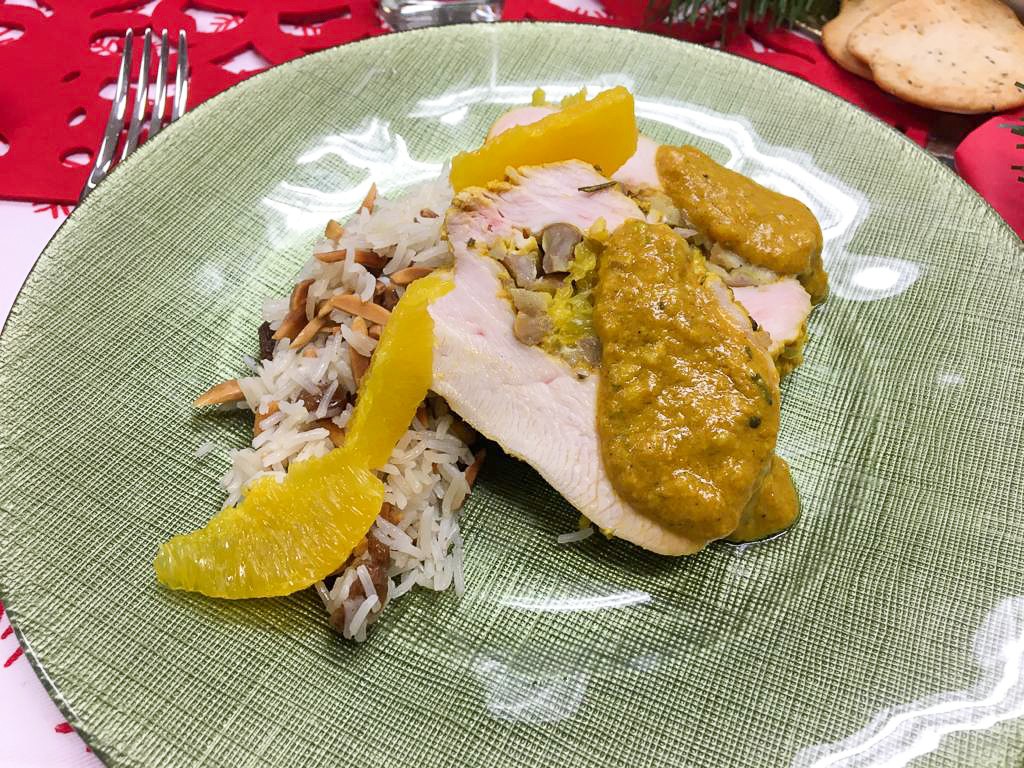
MEAT DISH
- Stuffed turkey tenderloins
The turkey is also found in the Christmas season in the homes of the Portuguese, depending on the region of the country. Thus, we suggest the turkey because it is a white meat, with a lower content of saturated fat than red meats. For a special touch, the turkey is stuffed with chestnuts, a seasonal fruit, high in fibre and vitamin C, a source of complex carbohydrates and magnesium, with a low fat content.
INGREDIENTS (4 pax.)
For the turkey:
400g Turkey tenderloins
2 Oranges
140g Chestnut kernels
Cinnamon (pinch)
Saffron (pinch)
Paprika (pinch)
Black pepper (pinch)
For the rice:
20g Fresh Rosemary
1 Garlic clove
40g Onion
6 Tb spoon olive oil
140g Basmati rice
40g Sultanas
1 Tea spoon corn flour
1 Coffee spoon salt
PREPARATION
Peel and release the orange segments, put aside the juice and segments.
Season the turkey tenderloins with spices, garlic, onion, rosemary, orange juice and olive oil. Marinate for 24 hours.
Roast the chestnut and, once cooled, chop coarsely.
Stuff the tenderloins with the chestnut and the orange.
Tie the tenderloins and bake at 160ºC for 30 minutes.
Sauté the sultanas, the clove of garlic and the rice briefly. Add 250ml of boiling water, season with salt and freshly ground black pepper. Cook the rice for 10 minutes, over low heat.
If the tenderloins are already roasted, if necessary, brown them for a while in a frying pan greased with oil. Slice the tenderloins.
Grind the roast sauce. Dissolve the corn flour in a small portion of the cold sauce. Put the rest of the sauce on the stove until it boils, add the dissolved corn flour and stir until it thickens.
Serve the tenderloins with the rice, the sauce, and a green salad!
Nutritional information (per person)

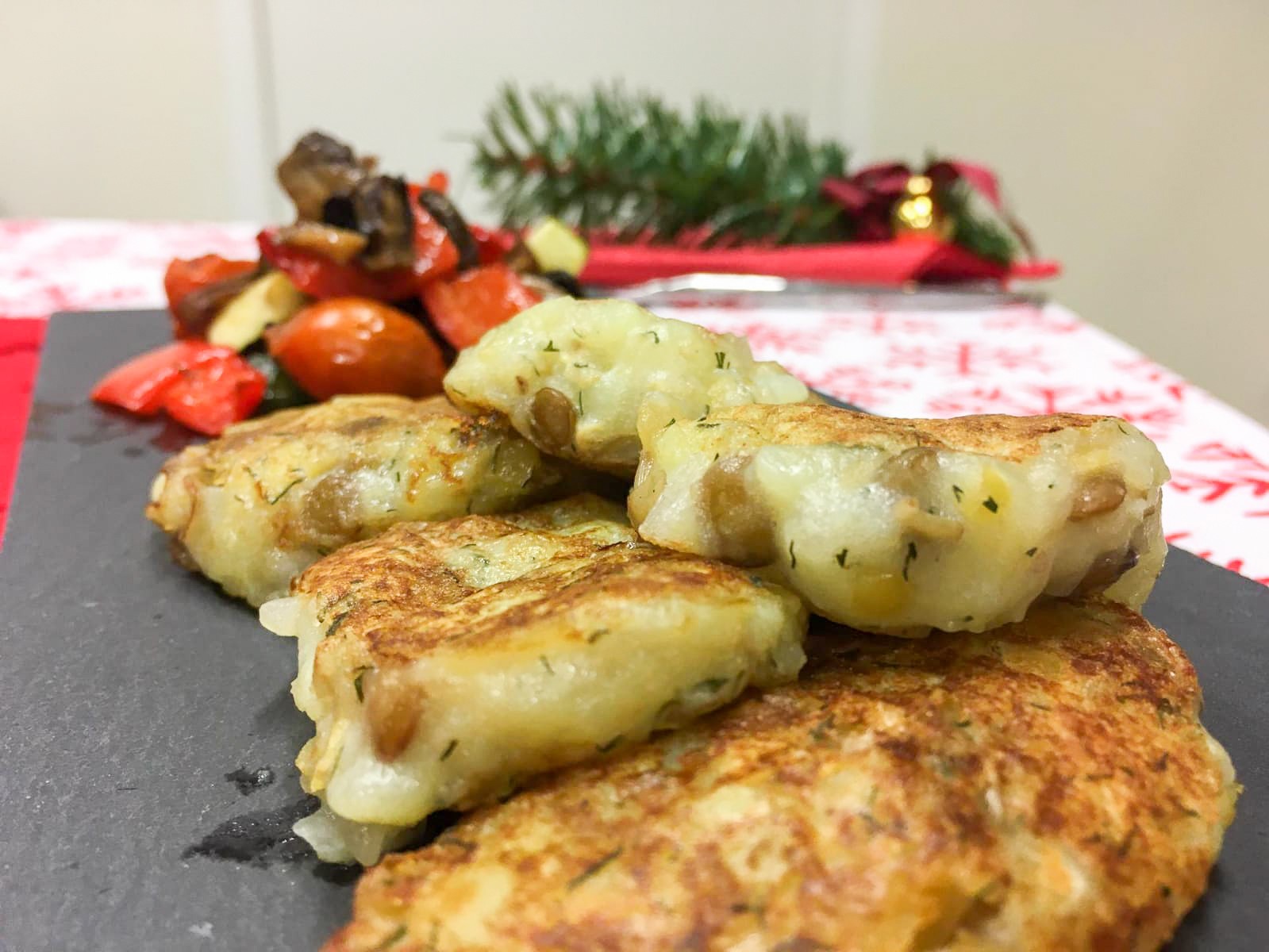
VEGETARIAN DISH
- Potato and lentils rosti with roasted vegetables
In order to cover all dietary patterns, our menu includes a dish adapted to all types of vegetarianism. The focus is on pulses, as they are a source of vegetable protein, rich in essential amino acids, and their consumption is encouraged in the Mediterranean diet. The principle for the preparation of this dish was the choice of unprocessed vegetable products.
INGREDIENTS (4pax.)
480g Potatoes for boiling
120g Lentils
100g Onion
Dill (pinch)
1 Tea spoon lemon juice
Black pepper (pinch)
1 Garlic clove
6 Tb spoon olive oil
200g Mushrooms
200g Courgette
200g Red pepper
100g Cherry tomatoes
PREPARATION
Wash, peel and boil the potatoes.
Cook the lentils in abundant water without salt.
Wash and chop mushrooms, courgette and red pepper. Wash the cherry tomatoes. Mix the above vegetables and season with olive oil and black pepper. Bake at 165ºC for 25 minutes. Drain the potatoes well and, while still warm, crush them.
In a deep container, mix the potatoes and lentils with the chopped onion, garlic and dill. Season the mixture with the black pepper. Make small round discs and let stand.
Brown the potato and lentil discs on both sides in a non-stick frying pan with a drizzle of olive oil.
Serve the rosti with the roasted vegetables.
Nutritional information (per person)

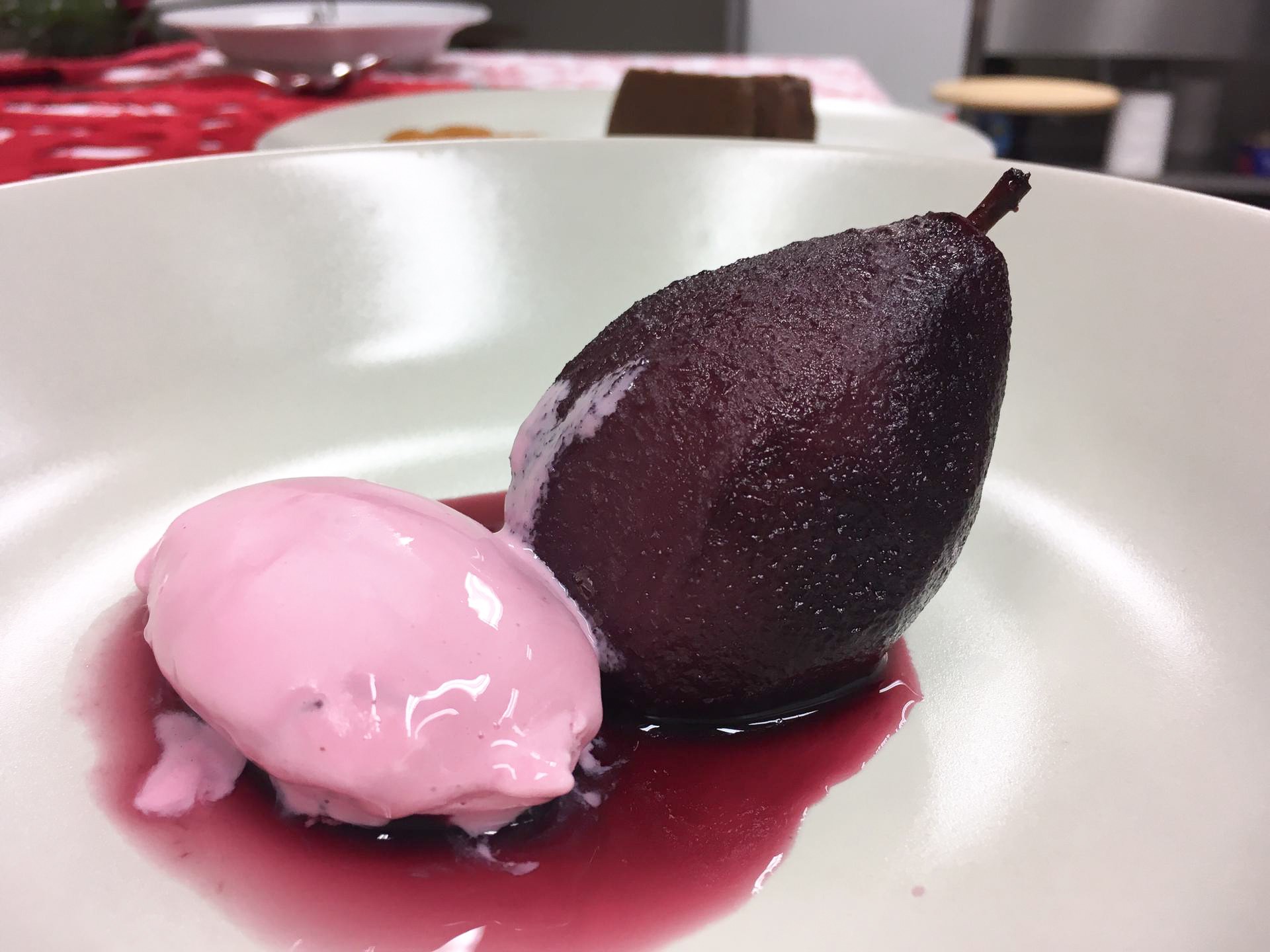
FRUIT (VEGETARIAN OPTION)
- Pears cooked in red wine
Fruit, being a naturally sweet food, should be the dessert of choice because it is rich in fibre, vitamins and minerals. For this festive day, we suggest a dessert with fruit as the main ingredient. Despite the addition of wine, the alcoholic content of the wine is evaporated during cooking, losing its energy value and giving only a different aroma to the pear. In addition, it is flavoured with cinnamon, which gives an even more pleasant taste to the dessert, without the need to add sugar.
INGREDIENTS (4 pax.)
4 Rocha pears
1.5 Lt Red wine
1 Cinnamon stick
1 Vanilla pod
4 Low-fat yogurt ice cream scoops (120g)
PREPARATION
Peel the pears. Cook them in a pan with red wine, cinnamon stick and vanilla pods. As soon as they are cooked, remove and let the pears drain. Let the syrup boil until it is just right. Pierce the pear for plating.
Serve the pears with a little syrup, accompanied by a quenelle of ice cream without lactose or added sugar.
Nutritional information (per person)

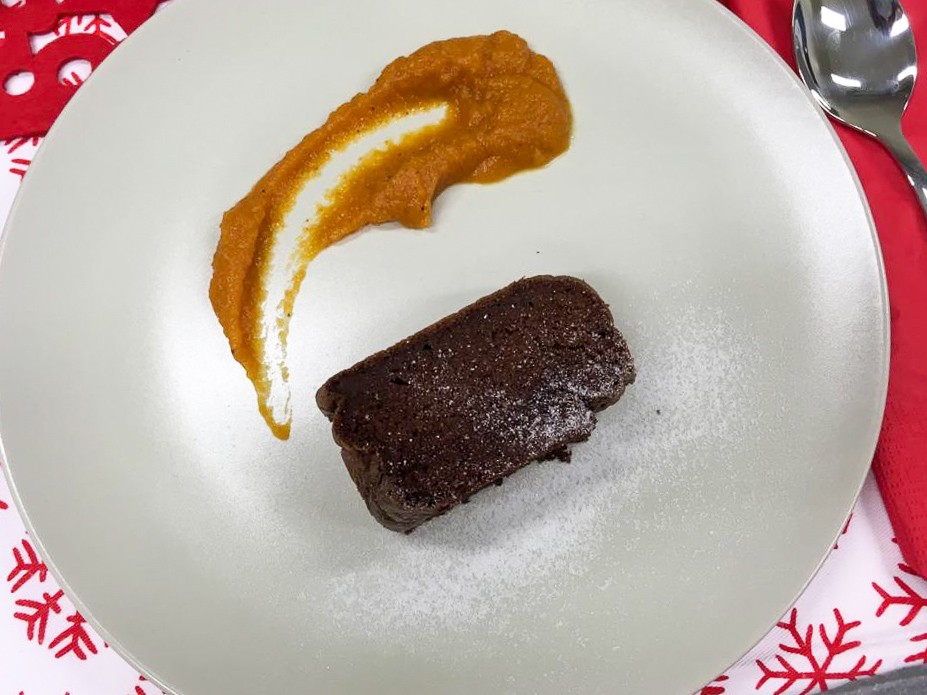
DESSERT
- Cocoa and pumpkin foam
This dessert is an adaptation to the typical cakes present on the Christmas table. Of its ingredients, we highlight pumpkin and cocoa. Pumpkin is composed of several substances with antioxidant characteristics, its predominant pigment being beta-carotene, partially converted into vitamin A in the body. Cocoa seems to have an effect in decreasing the risk of cardiovascular disease. Ideally, choose the versions without added sugar.
INGREDIENTS (4pax.)
300g Pumpkin
2 Tb Spoon honey
100 ml Water
40g Cocoa powder
120g Self-rising flour
4 Eggs S
1 Coffee spoon soluble coffee (1g)
9 Tb spoon olive oil
1 Vanilla pod
12g Bicarbonate
PREPARATION
Peel and break the pumpkin into pieces. Place the pumpkin to be boiled in water with honey, cinnamon sticks, cloves and nutmeg.
Dissolve coffee and cocoa in boiling water. Allow to cool slightly. Add the egg yolks, wrap around, and let stand. Add olive oil and vanilla and mix. Add the flour, wrapping everything.
Whisk egg whites with baking soda. With a spatula, carefully add the egg whites to the previous preparation. Bake at 150ºC for 15 minutes. Drain the pumpkin and mash with a little cinnamon and nutmeg.
Serve the dessert with pumpkin puree.
Nutritional information (per person)

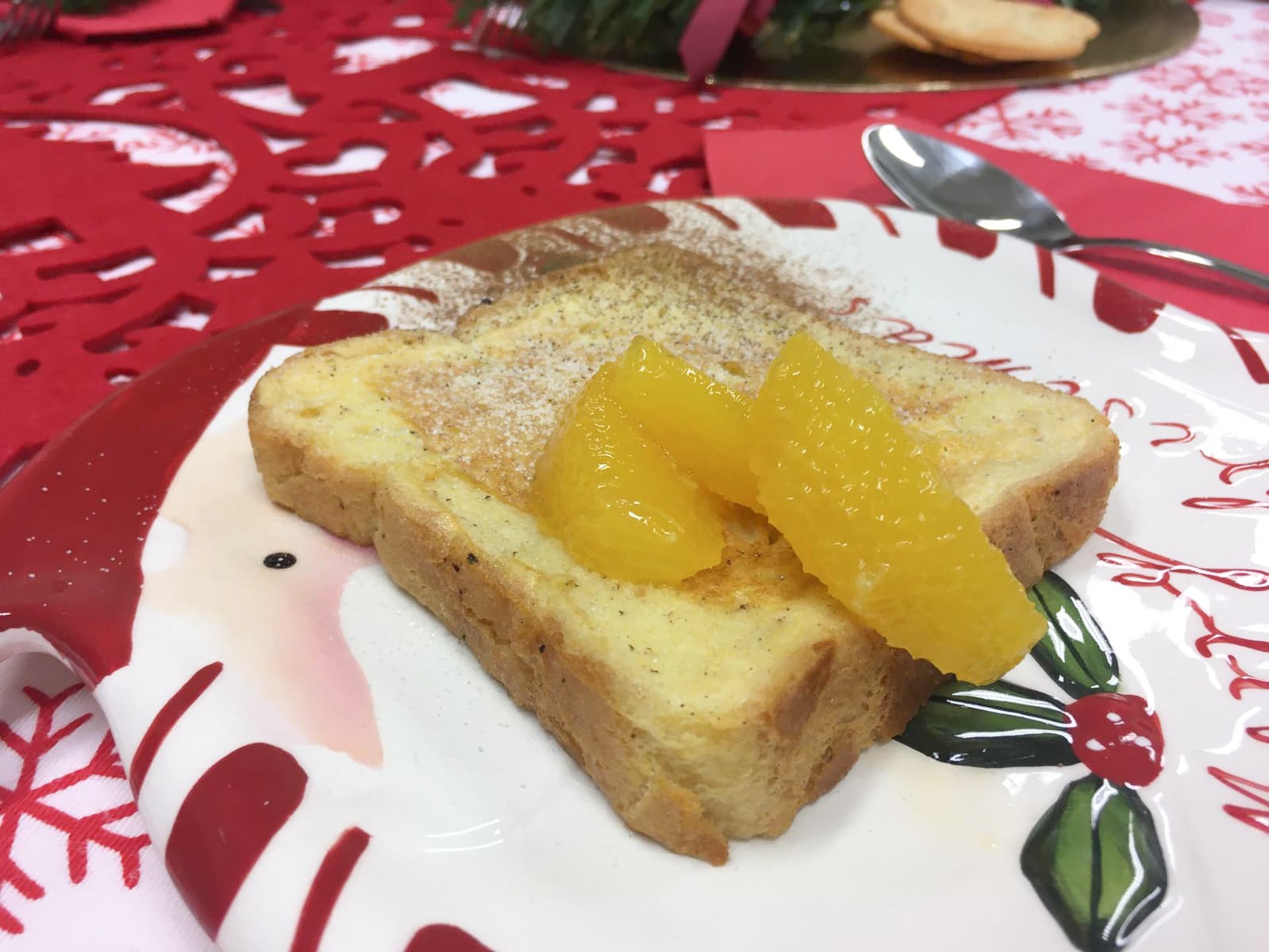
DESSERT
- French toast in the oven
French toast, sometimes called "golden slices", is a most traditional Christmas dessert. In this recipe, we recreated the typical Portuguese version of the French toast in a version with fewer calories, sugar and fat, but equally tasty. We substituted frying for oven cooking, sugar for cinnamon and orange flavouring and we chose to use milk in its lean version. To avoid food waste, we suggest using leftover bread to make this dessert.
INGREDIENTS (4 pax.)
4 Slices of bread (200g)
400ml Milk
1 Large orange
1 Cinnamon stick
1 Egg S
1 Dessert spoon icing sugar
Powdered cinnamon (pinch)
PREPARATION
In a saucepan, bring the milk, orange and cinnamon stick to the boil to make an infusion.
Slice the bread into approximately 2 cm thick slices. Soak in warm milk.
Dip the soaked bread slices into the whisked egg, then carefully place them on a tray lined with parchment paper.
Place in the oven at 185ºC until golden brown.
Place the French toast on a plate, garnish with powdered sugar, powdered cinnamon and orange slices. For those who like French toast with syrup, you can use a tea or infusion.
Nutritional information (per person)

Sofia Tavares
Editorial Team























































